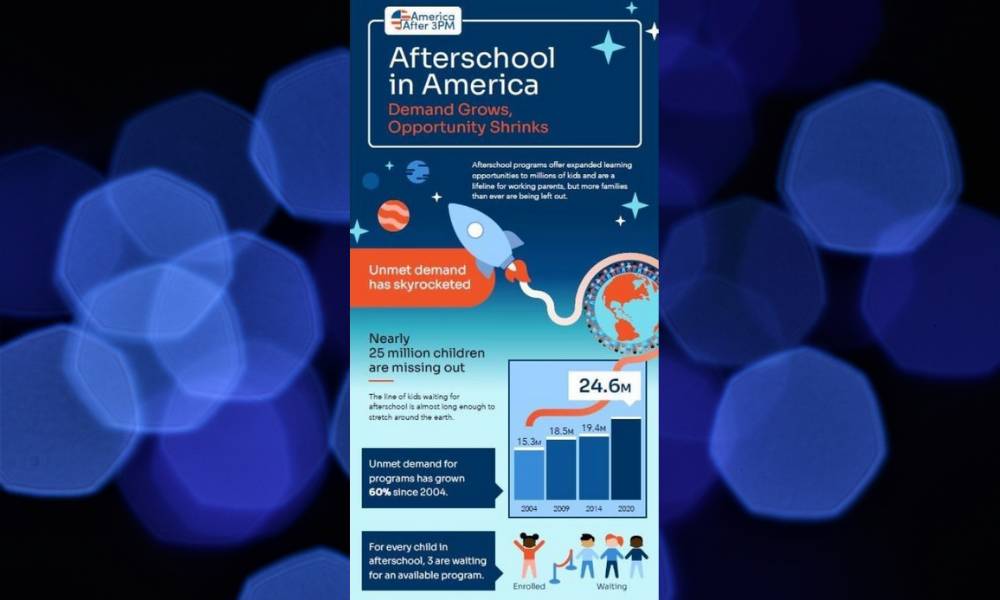
Parent satisfaction with afterschool programs has reached unprecedented levels, and unmet demand for these programs has skyrocketed. For every child in an afterschool program today, three more are waiting to get in, according to America After 3PM 2020, a household survey released last week.
Commissioned by the Afterschool Alliance and conducted by Edge Research, the new study finds that the families of 24.6 million children — more than ever before — are unable to access a program and many report cost as a barrier. It exposes significant inequities, with Black and Latinx children disproportionately affected: Parents of 58% of Black, 55% of Latinx, and 46% of white children not currently in an afterschool program say they would enroll their child if they could.
America After 3PM 2020 finds that afterschool participation has dropped precipitously, with fewer children in programs today than in 2009. The decline means more children lack essential supports that can help them succeed. It also signals that, while publicly funded afterschool programs have helped millions of students, public dollars are not nearly sufficient to keep up with demand today.
The study is based on responses from more than 30,000 U.S. families and builds on household surveys conducted in 2004, 2009 and 2014. It offers a pre-pandemic snapshot of how children and youth spend their afternoons and has significant implications for our post-pandemic world. It also includes a separate survey of parents conducted this fall.
Satisfaction with programs is the highest it has ever been, with 94% of parents of afterschool students saying they are satisfied with their child’s program (up from 89% in 2014). There is overwhelming recognition of the benefits afterschool programs provide, from helping kids engage with peers and reduce screen time to enhancing their interest in STEM (science, technology, engineering and math) to reducing their use of drugs and other risky behaviors. Eighty-seven percent of parents support public funding for afterschool programs — the highest level of support ever recorded.
“Parents say afterschool programs are doing a terrific job and helping meet many of their children’s needs. But investments in afterschool have failed to keep up with demand, and that puts millions of children and youth at risk. Without question, the pandemic is exacerbating the harm,” said Afterschool Alliance Executive Director Jodi Grant. “Quality afterschool programs are essential to student success in school and life. If we want to emerge from this pandemic strong, we need to provide all our children and youth access to the important enrichment opportunities and resources afterschool programs provide. We’re far from doing that now.”
Core findings from America After 3PM 2020:
- Unmet demand for afterschool programs is soaring. Demand has grown 60% since 2004, from 15.3 million children (30% of non-participants) waiting to get into a program in 2004 to 18.4 million children (38%) in 2009 to 19.4 million children (41%) in 2014 to 24.6 million children (50%) in 2020. All but six states saw an increase in unmet demand for afterschool programs from 2014 to 2020.
- Cost and access are barriers to participation, and inequities persist. Sixty-one percent of low-income parents report that cost is a barrier to enrolling their child in an afterschool program. Access (lack of a safe way for their child to get to and come back from a program) is a barrier for 58%. Both are significant increases from 2014.
- Higher-income families spend more than five times as much on out-of-school-time activities (roughly $3,600 per year) than families in the lowest income bracket ($700 per year).
- Just 7.8 million children are enrolled in an afterschool program today, down from a high of 10.2 million children in 2014. Inequities in terms of which students are accessing programs are stark. The number of children from low-income households participating in afterschool fell from 4.6 million in 2014 to 2.7 million in 2020, while the number of higher-income children in afterschool fell by just under 450,000 over the same period.
- The number of elementary school students on their own after school rose slightly to more than 850,000, an increase of almost 38,000 since 2014, while the number of middle and high school students dropped from 2014 to 2020.
- The Top 10 States for Afterschool in the new study are the District of Columbia, California, Florida, Alaska, Tennessee, North Carolina, Georgia, Missouri, Vermont and South Carolina – although none come close to meeting the demand for afterschool programs. To determine state rankings, composite state scores were calculated and indexed against the national average. Each state’s overall score is based on afterschool program participation, afterschool programs reaching children in need, and parents’ satisfaction with key features of their child’s afterschool program.
- Support for afterschool programs is strong. Parents give high marks to afterschool programs, with 83% agreeing programs give working parents peace of mind, 81% agreeing programs help parents keep their jobs, and 76% agreeing programs help children gain interest and skills in STEM – all increases from 2014.
- Low-income parents say programs help address a range of family needs. Three-quarters of low-income parents say the availability of snacks and meals was important in their selection of their child’s afterschool program. A similar number (76%) report that their child’s program offers classes or workshops that help the child build skills. Sixty-four percent say the program connects them to community resources that help address food insecurity, provides skill-building opportunities for parents and more.
- Eighty-seven percent of parents favor public funding for programs that provide afterschool opportunities to students in communities that have few opportunities for children and youth. Support crosses demographic and political divides, with 91% of parents who identify as Democratic, 87% of those who identify as Independent, and 85% of parents who identify as Republican favoring public funding.
“It is unacceptable that the parents of nearly 25 million students are struggling to find or afford an afterschool program,” Grant said. “The data suggest that parents who could find a way to pay for these programs in the past can no longer do so. Every parent should have access to an affordable, quality afterschool program that will keep their child safe, supervised and learning. This new study paints a picture of unmet need, with the heaviest burdens falling on low-income families and families of color.”
“During the pandemic, afterschool programs have been stepping up to meet the growing needs of students and families, even as programs face higher costs, dwindling budgets, and uncertain futures themselves,” Grant added. “Nationally, half of afterschool programs that are serving students in person, and are located in school districts that are operating virtually, have wait lists. We must do better. Publicly funded afterschool programs have been a lifeline for low-income children. We need to bring more federal, state, local, business and philanthropic support to meeting the needs of students and their families after school.”
Findings from America After 3PM 2020 are based on a nationally representative survey of randomly selected adults who live in the United States and are the parent or guardian of a school-age child who lives in their household. A total of 31,055 households were surveyed in English or Spanish, and a subset of households (14,391 respondents) answered follow-up questions regarding afterschool experiences or barriers to participation in afterschool, as well as perceptions of afterschool programs. Data from interviews are weighted on race and income within states and by state population. The overall margin of error for child-level and household-level data is +/- < 1 percent. The survey included at least 200 interviews in every state and the District of Columbia. Data were collected between January 27 and March 17, 2020, by Edge Research.
The October 2020 survey of parents was conducted by Edge Research and is a nationally representative online survey fielded October 12-29, 2020, of 1,202 parents of school-aged children.
America After 3PM 2020 is made possible with support from the New York Life Foundation, Overdeck Family Foundation, The Wallace Foundation, the S.D. Bechtel, Jr. Foundation, Altria Group, the Walton Family Foundation, and the Charles Stewart Mott Foundation.
The Afterschool Alliance is a nonprofit public awareness and advocacy organization working to ensure that all children and youth have access to quality afterschool programs.


Chattooga Schools
GNTC honors Electrical Lineworker graduates for fall 2024

Chattooga Local News
Secretary Raffensperger Announces the “Georgia Plan” for Federal Election Reform

Chattooga Local News
Georgia Auto Brokers’ Jason Vasser to Provide Free Thanksgiving Meal for Community

Bulloch Public Safety
11/04/2024 Booking Report for Bulloch County

Bulloch Public Safety
10/21/2024 Booking Report for Bulloch County

Bulloch Public Safety
10/17/2024 Booking Report for Bulloch County

Bulloch Public Safety
10/28/2024 Booking Report for Bulloch County

Bulloch Public Safety
11/07/2024 Booking Report for Bulloch County





